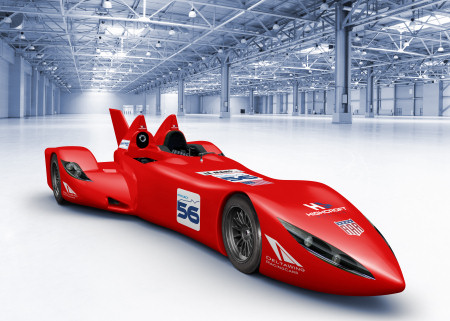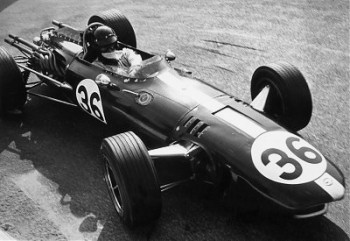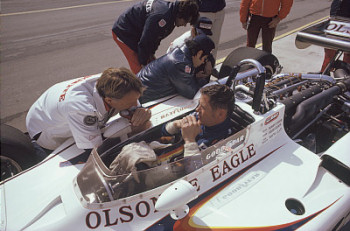The Way It Is/ All American Racers and the Delta Wing
by Gordon Kirby Many fans were delighted to hear that Ben Bowlby's Delta Wing prototype will be built this summer at Dan Gurney's All American Racers and raced at Le Mans next year by Duncan Dayton's ALMS champions Highcroft team. The birth of the radical Delta Wing will be a much-needed boost for a sport that's become deeply conservative and many of us look forward with excitement to the Eagle Delta Wing's testing and development program and its competitive debut at next year's Le Mans 24 hour race.
Many fans were delighted to hear that Ben Bowlby's Delta Wing prototype will be built this summer at Dan Gurney's All American Racers and raced at Le Mans next year by Duncan Dayton's ALMS champions Highcroft team. The birth of the radical Delta Wing will be a much-needed boost for a sport that's become deeply conservative and many of us look forward with excitement to the Eagle Delta Wing's testing and development program and its competitive debut at next year's Le Mans 24 hour race.
Designer Bowlby spent a few days at All American Racers last week working on plans for the construction of the first Delta Wing which will soon begin. The Delta Wing will be powered by a 1.6 liter turbo four-cylinder engine, manufacturer not yet known. The 800 lb car is designed to race with a 300 hp engine of this type and it will be interesting to learn the identity of the engine builder. Favorites seem to be Ford or Chevrolet, but those are only guesses. The other key component to be settled are the tires which will come from either Bridgestone/Firestone or Michelin.
"It's coming together quite excitingly," Bowlby said last week. "Dan is a superstar, you know, and it's great to have an ally like him. I think he's achieved so much because he's a very intelligent and talented man, but also because he's a fine fellow and everybody around him is glad to be there and enjoys his company. It's really a magical environment."
Gurney celebrated his 80th bithday in April but he's as motivated as ever and entirely rejuvenated by the Delta Wing project.
"The people here are all very excited about it," Dan said. "There's not much to say right now. There's a lot of work ahead of us. There are quite a few important elements that need to be nailed down before we start talking about what we're doing but it's extraordinarily exciting. I think it will appeal to a lot of people globally."
As discussed in a column posted here on August 9th last year called 'Celebrating Dan Gurney's innovative spirit' we talked about how Dan presciently predicted the Delta Wing in a conversation back in 2006. Dan synopsized his recipe for the race car of the 21st century and remarkably and perhaps unsurprisingly his concept was almost identical to Bowlby's Delta Wing design. Because his observations are so important it's worth reprising many of Dan's comments from last August's column, starting with his ideas for the race car of the future put forward five years ago.

© Delta Wing
"A four-cylinder engine can put out a lot of power and is probably the least costly. It probably doesn't need anymore than 650 horsepower. I think it should be no bigger than 1,800 cc. It could be as small as 1,000 cc. 300 horsepower per liter is not hard to make on essentially pump gas.
"You could maybe even allow two-strokes, if they could match the emissions or fuel usage--something that would have some relevance to what's going on in the world. You probably also need to restrict some of the metallurgical side of things."
Dan has always been one to find his own path against the accepted trend. In many ways this is the essence of the man's infectiously free spirit.
"I feel that there's a joy in being unconventional or questioning conventional wisdom," he said. "Why are things the way they happen to be and what's the history of how it evolved? Often you find out it wasn't decided on merit, it was decided by some outside aspect--a political decision, or bureaucratic mess, or lack of leadership, or all kinds of other things."
Through AAR's thirty-four year run as a race car constructor from 1966-'99, innovation was always essential to the company.

© LAT USA
"It's a fun thing to do, for sure. You appreciate other people doing things when you read the history books. If you feel that in some small way you can join this illustrious bunch of people who have done things, it's worth having a go at it."
In many ways Dan is a man whose time has passed. He was a Southern California hot-rodder who grew up in the can-do days of the forties and fifties and was party to many of racing's great technological breakthroughs during the sixties and seventies. But over the past thirty years the prevailing view of the sport's rulesmakers and powerbrokers has run antithetically to the spirit of All American Racers.
For years any kind of major innovation has been expresssly prohibited from racing's rule books from CanAm through USAC, CART, IMSA, IRL, even F1. Today, in all categories, the general layout of the chassis, aerodynamics and engine are very strictly defined. There's no room to introduce a 1963 Lotus-Ford Indy car, for example, or a Gurney/Weslake V12, or an '81 Eagle-Chevy Indy car, least of all a turbine-powered car or a Chaparral in all its high-winged glory.
"As a fan," Dan observed, "I think the idea that you couldn't predict how the next race was going to shape up and what new technological innovations were going to crop up was fantastic. The idea was that the rules were essentially open. You could probably put the rules on one page and I think that was a huge draw to drivers, engineers--all the people involved--plus the fans. It's a shame to be railing against bureaucrats all the time but the idea that there was open creativity with the cars was very important."
Dan fondly recalled the intellectual effort that went into inventing things like the Gurney flap.
"The intensity of focusing and thinking when you're in that situation is just mind-boggling. You seem to be able to come up with things in those situations. Necessity is the mother of invention, and darned if that doesn't have a lot of the ring of truth to it. The competitive drive, the intensity that is involved, makes things happen.

© LAT USA
Dan believes wings should be eliminated from racing cars. He'd like to see at least one sanctioning body try an experiment of testing cars with ground-effect underbodies but without any external wings. He believes this would form the basis of a new formula for the future with less aerodynamic influence on the cars making it possible to see more outbraking and passing.
"To me, in terms of the spin-off to road cars, wings are irrelevant," Dan observed. "They've also distorted the whole driving picture. I would study it carefully and get rid of wings."
Dan believes some creative thinking is required by the sport's power brokers to encourage racing to develop new technologies and power sources.
"There should be huge interest in these things from the industry," he mused. "I think there needs to be a good citizenship aspect to it. In the end, you're going to be competing in the future with fuel cells and hybrids. Why make it so you essentially can't compete? Why not open it up so the fuel companies will say they'll find some of their future edge through racing?
"Maybe the piston engine has more lives yet. Maybe it could be something else entirely. That requires a lot of thought. But if you could figure out a way to make really good mileage through racing, that would surely be good.
"What do people want to see?" Dan added. "Do they want to see who can do it best? Do they want to see something else? Maybe racing overall is getting obsolete. That thought does come to mind, doesn't it? Today and for many years, it's been about making the cars slower and cheaper rather than faster and more interesting."
So Dan said a few years ago. Now with the Delta Wing he has the opportunity to put many of his theories to the test which is exactly the shot in the arm the sport needs.
Auto Racing ~ Gordon Kirby
Copyright 2011 ~ All Rights Reserved
Copyright 2011 ~ All Rights Reserved
Top of Page